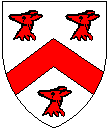Back to the Glossary
Deer and other Animals
Deer
Deer are a common sight in heraldry. They are usually described as stags (with antlers) or hinds (the females, without), but one also comes across hart and buck (representing different kinds of deer: the stag and hart have branched, pointed antlers representing red deer, whereas the buck has flat palmated horns representing the fallow deer).
 Deer are said to be attired and unguled, i.e. antlered and hoofed [in a particular colour]. Often only the head is shown, for instance Malbis ( Argent a chevron between three hindís heads erased gules).
Deer are said to be attired and unguled, i.e. antlered and hoofed [in a particular colour]. Often only the head is shown, for instance Malbis ( Argent a chevron between three hindís heads erased gules).
Other Animals
 There are many, many other animals depicted in heraldry, for instance wolves (frequently just as heads), goats, bulls, bears, boars... and the talbot or hunting dog (right). Dogs, especially greyhounds, are frequently shown running or courant, and if in pursuit of another animal in full chase or in full course.
There are many, many other animals depicted in heraldry, for instance wolves (frequently just as heads), goats, bulls, bears, boars... and the talbot or hunting dog (right). Dogs, especially greyhounds, are frequently shown running or courant, and if in pursuit of another animal in full chase or in full course.
Almost any animal can be found, including the hedgehog or urchin, bat or flittermouse and even elephants. Such animals are probably most often met with in their natural colours or proper, in contrast with the more stylised deer, wolf, bear and so on which are treated as charges and blazoned in heraldic colours. If part of an animal such as the haed or leg (gamb or jamb) is shown, it is said to be couped if its edge is a clean straight line, erased if it is ragged, as in the Malbis arms above.
Also, of course, one must not forget the heraldic monsters, which vary from the relatively well known dragons to strange beasts indeed.
Postures and Positions
Deer can be found in all manner of different positions on shields. There is a specialised vocabulary to describe these, mostly derived from mediaeval or Norman French. The terms used for deer are different from those used for lions. The terms used for other animals are usually the same as those for lions, but goats and other cloven-footed creatures (except bulls) share those used for deer. Monsters sometimes have their own terms, for example a griffin is said to be segreant instead of rampant.
Back to the Glossary Contents.
© Gill Smith 1997 – 1999
 Deer are said to be attired and unguled, i.e. antlered and hoofed [in a particular colour]. Often only the head is shown, for instance Malbis ( Argent a chevron between three hindís heads erased gules).
Deer are said to be attired and unguled, i.e. antlered and hoofed [in a particular colour]. Often only the head is shown, for instance Malbis ( Argent a chevron between three hindís heads erased gules). There are many, many other animals depicted in heraldry, for instance wolves (frequently just as heads), goats, bulls, bears, boars... and the talbot or hunting dog (right). Dogs, especially greyhounds, are frequently shown running or courant, and if in pursuit of another animal in full chase or in full course.
There are many, many other animals depicted in heraldry, for instance wolves (frequently just as heads), goats, bulls, bears, boars... and the talbot or hunting dog (right). Dogs, especially greyhounds, are frequently shown running or courant, and if in pursuit of another animal in full chase or in full course.